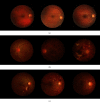Hypermixed Convolutional Neural Network for Retinal Vein Occlusion Classification
- PMID: 36408465
- PMCID: PMC9674409
- DOI: 10.1155/2022/1730501
Hypermixed Convolutional Neural Network for Retinal Vein Occlusion Classification
Abstract
Retinal vein occlusion (RVO) is one of the most common retinal vascular diseases leading to vision loss if not diagnosed and treated in time. RVO can be classified into two types: CRVO (blockage of the main retinal veins) and BRVO (blockage of one of the smaller branch veins). Automated diagnosis of RVO can improve clinical workflow and optimize treatment strategies. However, to the best of our knowledge, there are few reported methods for automated identification of different RVO types. In this study, we propose a new hypermixed convolutional neural network (CNN) model, namely, the VGG-CAM network, that can classify the two types of RVOs based on retinal fundus images and detect lesion areas using an unsupervised learning method. The image data used in this study is collected and labeled by three senior ophthalmologists in Shanxi Eye Hospital, China. The proposed network is validated to accurately classify RVO diseases and detect lesions. It can potentially assist in further investigating the association between RVO and brain vascular diseases and evaluating the optimal treatments for RVO.
Copyright © 2022 Guanghua Zhang et al.
Conflict of interest statement
The authors declare that there is no conflict of interest regarding the publication of this paper.
Figures









Similar articles
-
Primary angle closure and primary angle closure glaucoma in retinal vein occlusion.Acta Ophthalmol. 2019 May;97(3):e364-e372. doi: 10.1111/aos.13879. Epub 2018 Sep 21. Acta Ophthalmol. 2019. PMID: 30239140
-
Automated segmentation of retinal nonperfusion area in fluorescein angiography in retinal vein occlusion using convolutional neural networks.Med Phys. 2021 Feb;48(2):648-658. doi: 10.1002/mp.14640. Epub 2020 Dec 23. Med Phys. 2021. PMID: 33300143
-
Assessing retinal vein occlusion based on color fundus photographs using neural understanding network (NUN).Med Phys. 2023 Jan;50(1):449-464. doi: 10.1002/mp.16012. Epub 2022 Oct 24. Med Phys. 2023. PMID: 36184848 Free PMC article.
-
Retinal vein occlusion.Indian J Ophthalmol. 1994 Sep;42(3):109-32. Indian J Ophthalmol. 1994. PMID: 7829175 Review.
-
Ischemic retinal vein occlusion: characterizing the more severe spectrum of retinal vein occlusion.Surv Ophthalmol. 2018 Nov-Dec;63(6):816-850. doi: 10.1016/j.survophthal.2018.04.005. Epub 2018 Apr 27. Surv Ophthalmol. 2018. PMID: 29705175 Review.
Cited by
-
MSLI-Net: retinal disease detection network based on multi-segment localization and multi-scale interaction.Front Cell Dev Biol. 2025 Jun 6;13:1608325. doi: 10.3389/fcell.2025.1608325. eCollection 2025. Front Cell Dev Biol. 2025. PMID: 40546319 Free PMC article.
-
Artificial Intelligence (AI) for Early Diagnosis of Retinal Diseases.Medicina (Kaunas). 2024 Mar 23;60(4):527. doi: 10.3390/medicina60040527. Medicina (Kaunas). 2024. PMID: 38674173 Free PMC article. Review.
-
Research progress on diagnosing retinal vascular diseases based on artificial intelligence and fundus images.Front Cell Dev Biol. 2023 Mar 28;11:1168327. doi: 10.3389/fcell.2023.1168327. eCollection 2023. Front Cell Dev Biol. 2023. PMID: 37056999 Free PMC article. Review.
-
Artificial intelligence in retinal image analysis for hypertensive retinopathy diagnosis: a comprehensive review and perspective.Vis Comput Ind Biomed Art. 2025 May 1;8(1):11. doi: 10.1186/s42492-025-00194-x. Vis Comput Ind Biomed Art. 2025. PMID: 40307650 Free PMC article. Review.
-
Intelligent diagnosis of retinal vein occlusion based on color fundus photographs.Int J Ophthalmol. 2024 Jan 18;17(1):1-6. doi: 10.18240/ijo.2024.01.01. eCollection 2024. Int J Ophthalmol. 2024. PMID: 38239946 Free PMC article.
References
-
- Horton William B., Jahn Linda A., Hartline Lee M., Aylor Kevin W., Patrie James T., Barrett E. J. Hyperglycemia does not inhibit Insulin's effects on microvascular perfusion in healthy humans: a randomized crossover study. American Journal of Physiology Endocrinology and Metabolism . 2020;319(4):E753–E762. doi: 10.1152/ajpendo.00300.2020. - DOI - PubMed
-
- Perry M. Eye disease in older adults: risk factors and treatments. Journal of Community Nursing . 2020;34(3)
MeSH terms
LinkOut - more resources
Full Text Sources

